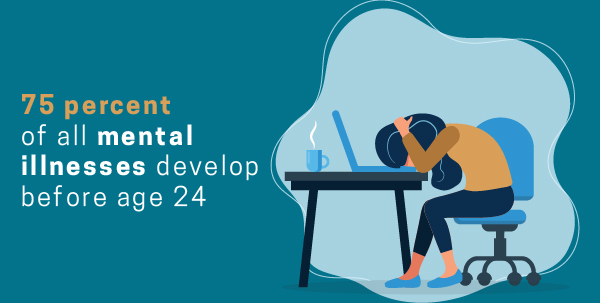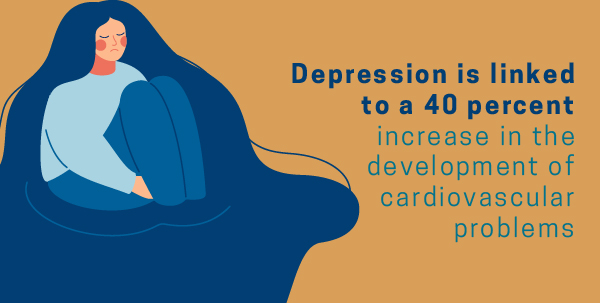Mood Disorders Overview
An estimated 21.4 percent of American adults will be affected by different types of mood disorders in some form within their life.1 After excluding prenatal and birth related hospitalizations, mood disorders are one of the most common causes of hospitalization in adults under 45 years old.2
Mood disorders pose a widespread public health problem. So understanding the different types of mood disorders, their causes and symptoms, and what kinds of mood disorder treatment are available is a significant part of fostering positive mental health and managing the effects of these mental illnesses.
What Are Mood Disorders?
The term “mood disorder” is a broad classification of a multitude of mental illnesses. These types of mental disorders affect how the brain functions, particularly in regard to emotions. Adults and children can be affected by different kinds of mood disorders and no two mood disorders are alike. The specific disorder a person has, their individual symptoms, the severity of their illness, and their external circumstances, will all factor into a person’s mental health experience.
Types of Mood Disorders
Major or Clinical Depression
Depression is the most common mood disorder, affecting 280 million people in the world.3 While everyone may feel sad at times, depression is a mental illness with symptoms that go far beyond just simply feeling sad.
Just as there are different types of mood disorders, there are also different types of depression.
A Deeper Look at Depressive Disorders
Postpartum Depression (Peripartum Depression)
Postpartum depression (PPD) is a type of depression that occurs after childbirth. It is normal for the mind and body to experience immense amounts of stress during pregnancy and labor, but if more than two weeks pass after your birth and you are still feeling symptoms of depression or are having difficulty developing an emotional bond with your newborn, it could be a sign of postpartum depression.
Studies show that PPD occurs in 11 percent of women after birth.4 Learning to identify the symptoms can help you to receive help sooner, creating a healthier future for you and your child.
Some of the symptoms of PPD include
- Depression that goes beyond so-called “baby blues”
- Difficulty emotionally connecting to your child
- Mood swings
- Anxiety
- Trouble concentrating.
Persistent Depressive Disorder (Dysthymia)
Seasonal Affective Disorder (SAD)
Psychotic Depression
Depression Related to Substance Abuse
Depression can sometimes occur as the result of a substance use disorder or substance abuse. While recovery can help reduce the symptoms of depression, withdrawal should be conducted in a medical setting to help reduce the risk of side effects.
However, once the body has completely eliminated all traces of the abused substance and returned to its natural function, the symptoms of depression usually resolve themselves. Withdrawal and recovery can be a long process, sometimes lasting several weeks or even months.
Bipolar Disorders
Bipolar disorder is a disorder that affects many people. It’s characterized by cycling between mania and depression. Episodes of either mania or depression usually take place over a span of weeks. Despite common misconceptions, instantaneous and abrupt mood swings are not characteristic of the disorder.
The cause of bipolar disorder has not yet been identified, though correlations between genetics, environment, altered brain anatomy and chemistry, and developing disorder have been made.
There are two types of bipolar disorder. Both are characterized by episodes of extreme mania or depression but there are significant differences between the two.
Overview of Bipolar Disorder
Bipolar Type I vs. Bipolar Type II
The number one defining characteristic that sets bipolar I apart from bipolar II is the severity of manic episodes. Bipolar I is characterized by experiencing full manic episodes. Bipolar II is characterized by hypomanic episodes, a less severe form of mania.
With regard to depressive episodes, bipolar type I may or may not include depressive episodes. However, the diagnostic criteria for bipolar type II requires the experience of major depressive episodes.
The frequency and severity of these episodes can be made worse by a number of factors including
- Stress
- Lack of sleep
- Poor diet
- Lack of exercise
- Substance abuse
Cyclothymia Disorder (Cyclothymia)
Signs and symptoms can include
- Euphoria
- Extreme optimism
- Grandiose self-image
- Increased talkativity
- Poor judgment and decision making
- Increased irritability

Other Mood Disorders
While the aforementioned above are the most common types of mood disorders, there are other types. There are mood disorders that can occur as a result of substance use disorders or as a symptom of some other general medical condition. Any disturbance in mood severe enough to have clinically-significant impacts or effects could likely be classified as some kind of mood disorder. As all individuals experience a relationship between their mental health and their mood, it seems reasonable that mood disorders would be so common.
Additional mood disorders include:
- Premenstrual dysphoric disorder (PMDD): A disorder in which approximately a week before menstruation a person’s mood becomes diminished. Sufferers may experience depression, anxiety, agitation, or thoughts of harming themselves or others.5
- Intermittent explosive disorder (IED): Individuals who experience sudden bursts of unexplained and uncontrollable rage disproportionate to the situation may be experiencing IED. The disorder affects approximately 7.3% of adults.6
Mood Disorders Causes and Risk Factors
What Causes Mood Disorders?
Mood Disorders Risk Factors
- Family history
- Trauma or major life changes
- Physical illness or use of certain drugs
- Brain function
- Environment

Signs and Symptoms of Mood Disorders
While some fluctuation in emotion is normal, especially following instances of acute stress–such as the death of a loved one, or changing jobs–persistent changes in mood can indicate the possibility of a mood disorder.
Common Symptoms of Major Depression
- Feelings of hopelessness
- Increased irritability
- Lack of interest in activities
- Changes in sleeping patterns
- Weight gain or loss
- Anxiety
- Difficulty concentrating
- Memory problems
- Fatigue
- Feelings of worthlessness, shame, or guilt
- Thoughts of death
- Suicidal thoughts or actions
Common Symptoms of Bipolar Disorder
- Depression
- Lack of energy
- Self-doubt
- Mild delusions
- Lack of appetite
- Illogical thinking
- Manic behaviors
- Grandiose thoughts or inflated self-image
- Distractibility
- Irritability
- Excessive energy
Mood Disorder Diagnosis
Like any other illness, a professional healthcare provider such as a doctor, or, in the case of a mental illness, psychiatrist, will be able to evaluate the present signs and symptoms and provide a diagnosis. Your doctor may utilize several different methods when diagnosing a potential mood disorder.
How Are Mood Disorders Diagnosed?
Physical Exams
Lab Tests
Psychiatric Evaluation

Diagnostic Criteria for Common Mood Disorders
Diagnostic Criteria for Depression
Diagnostic Criteria for Bipolar Disorder
Providers attempting to diagnose bipolar disorder will typically ask patients to describe their symptoms of mania, and depression, to determine if they meet the diagnostic criteria for bipolar disorder. Diagnostic screening tools, like self-reported surveys, are often used in this process. In order to meet the diagnostic criteria for bipolar disorder type I, the patient must have experienced at least one manic episode which lasted for at least a week or resulted in hospitalization and have other symptoms consistent with the disorder. For bipolar type II, a person must have experienced a hypomanic episode, and meet other diagnostic criteria.8
Mood Disorders Prevention
Can Mood Disorders Be Prevented?
It’s important to maintain a healthy connection with your mind and body to notice when something may not be right. If you have symptoms that are concerning, you should see your doctor to formulate an effective treatment plan.
When To See a Doctor
- Hormonal changes
- Menstruation
- Acute stress
- Lack of sleep
- Hunger
Treatments for Mood Disorders
Medications
A pharmaceutical approach can be beneficial in treating mood disorders. Medications such as antidepressants are often utilized in helping reduce the severity of symptoms while also promoting more balanced brain chemistry. Some of the most common medications used as a mood disorder treatment include
- Antidepressants
- Mood stabilizers
- Anxiety medication
While medication can be helpful as a form of mood disorder treatment, studies have shown that oftentimes a single medication is not fully effective on its own in around half the cases of mood disorders.9
Psychotherapy
Psychotherapy is a holistic, research-backed method of better understanding and promoting mental well-being in the face of a mental illness. One of the most commonly utilized psychotherapy methods is Cognitive-Behavioral Therapy, which can help rebalance the mind and body while fostering understanding of how certain mindsets and thoughts can result in different behaviors.
CBT is especially beneficial in treating mood disorders and substance use disorders.
A Deeper Look at Psychotherapy
A Combination of Psychotherapy and Medication
Treatment for Mood Disorders at Pacific Beach Health

Navigating a mood disorder can be difficult. It can be hard to connect with those around you, and you may not feel like your best self. However, treatment can help restore balance to your life by addressing the root cause of a mood disorder while also helping reduce the severity of symptoms.
At Pacific Beach Health, you can find a variety of holistic mental illness treatments designed to help you reconnect with those around you while also realigning your mind, body, and spirit.
Our Mood Disorders Treatment Programs
Mood disorders can alter the way you’re able to interact with your surroundings–whether it’s with your family and loved ones or with your environment. The emotional volatility associated with mood disorders can make it difficult to maintain and navigate personal relationships, and can often create situations where you feel out of sync with those around you.
At Pacific Beach Health, we specialize in treating mood disorders through a holistic approach that integrates diverse therapies to help individuals with mood disorders to better regulate and understand their emotions, restore mind-body balance, and foster healthier interactions with loved ones.
What to expect
Here at Pacific Beach Health we believe in taking advantage of the beautiful southern California area with our ecopsychology approach. This unique type of therapy combines traditional, research-based psychotherapies with nature-oriented activities to allow you to explore your environment while reconnecting with the things that matter most.
You can expect to find a welcoming, family-like setting with a focus on spiritual integration and emotional recovery. We offer a variety of therapies and counseling, as well as additional service to help you better understand and treat your mood disorder.
Call us today
As of now, there is no cure for mood disorders. However, treatment can help to manage symptoms and reduce their severity, all while providing healthy coping mechanisms to help you to better interact with your families and loved ones, connect with yourself, and reclaim the joy once had.
To begin your mental health journey today, contact us.
Resources
- https://www.hcup-us.ahrq.gov/faststats/NationalDiagnosesServlet
- https://www.who.int/news-room/fact-sheets/detail/depression
- https://www.cdc.gov/mmwr/volumes/66/wr/mm6606a1.htm
- https://www.mercy.net/service/mood-disorders/
- https://www.nih.gov/news-events/news-releases/intermittent-explosive-disorder-affects-16-million-americans
- https://www.nature.com/articles/5201549
- https://sharedsystems.dhsoha.state.or.us/DHSForms/Served/le7549b.pdf
- https://www.nature.com/articles/nn943


